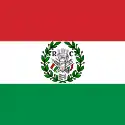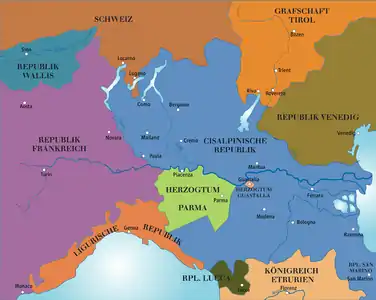Sister republic
A sister republic (French: république sœur) was a republic established by French armies or by local revolutionaries and assisted by the First French Republic during the French Revolutionary Wars. These republics, though nominally independent, relied heavily on France for protection, and aid when push came to shove, which made the republics more of autonomous states, rather than an independent republic, which was shown after the declaration of the First French Empire, when several states were annexed, and the remaining turned into puppet monarchies.

History
The French Revolution was a period of social and political upheaval in France from 1789 until 1799. The Republicans who overthrew the monarchy were driven by ideas of popular sovereignty, rule of law and representative democracy. The Republicans borrowed ideas and values from Whiggism and Enlightenment philosophers. The French Republic supported the spread of republican principles in Europe, but most of these sister republics became a means of controlling occupied lands as client regimes through a mix of French and local power.[1]
Sister republics of Italy
 Subalpine Republic (1800–1802) annexed to the French Republic
Subalpine Republic (1800–1802) annexed to the French Republic
.svg.png.webp) Piedmontese Republic (1798–1799), conquered by Austro-Russian troops and rendered back to Sardinia, but reconquered by Napoleon in 1800 and renamed Subalpine Republic (Novara to the Italian Republic)
Piedmontese Republic (1798–1799), conquered by Austro-Russian troops and rendered back to Sardinia, but reconquered by Napoleon in 1800 and renamed Subalpine Republic (Novara to the Italian Republic)
 Republic of Alba (1796) reconquered by the Kingdom of Sardinia
Republic of Alba (1796) reconquered by the Kingdom of Sardinia
 Parthenopean Republic (1799) reconquered by the Sanfedisti for the King of Naples and Sicily
Parthenopean Republic (1799) reconquered by the Sanfedisti for the King of Naples and Sicily
- Republic of Pescara (1799) re-united with the Kingdom of Naples
 Roman Republic (1798–1799) ended with the restoration of the Papal States
Roman Republic (1798–1799) ended with the restoration of the Papal States
- Republic of Ancona (1797–1798) joined Roman Republic
- Tiberina Republic (1798–1799) joined Roman Republic
 Ligurian Republic (1797–1805) annexed to the French Empire
Ligurian Republic (1797–1805) annexed to the French Empire.PNG.webp) Republic of Lucca (1799 and 1800–01), later continued (1801–05) under the old oligarchy and it was replaced by the Principality of Lucca and Piombino
Republic of Lucca (1799 and 1800–01), later continued (1801–05) under the old oligarchy and it was replaced by the Principality of Lucca and Piombino_with_coat_of_arms.svg.png.webp) Italian Republic (1802–1805) transformed into the Kingdom of Italy
Italian Republic (1802–1805) transformed into the Kingdom of Italy
 Cisalpine Republic (1797–1802) transformed into the Italian Republic
Cisalpine Republic (1797–1802) transformed into the Italian Republic
 Cispadane Republic (1796–1797) formed the Cisalpine Republic
Cispadane Republic (1796–1797) formed the Cisalpine Republic
- Bolognese Republic (1796) annexed to the Cispadane Republic
 Transpadane Republic (1796–1797) formed the Cisalpine Republic
Transpadane Republic (1796–1797) formed the Cisalpine Republic Republic of Crema (1797) formed the Cisalpine Republic
Republic of Crema (1797) formed the Cisalpine Republic- Republic of Bergamo (1797) formed the Cisalpine Republic
- Republic of Brescia (1797) annexed to the Cisalpine Republic
 1792: Northern Italy before
1792: Northern Italy before
the French invasion 1803: Sister Republics
1803: Sister Republics
in Northern Italy (the map has an error in Novara and Veneto) Sister Republics
Sister Republics
replaced by monarchies (same error for Novara)
Other sister republics

 Republic of Bouillon (1794–1795)
Republic of Bouillon (1794–1795) Republic of Liège (1789–1791)
Republic of Liège (1789–1791)- Republic of Rauracia (1792–1793) revolutionary French republic in Basel
- Lémanique Republic (1798) joined the Helvetic Republic
- Republic of Mainz (1793) revolutionary French republic in Rhenish Hesse and the Electoral Palatinate
 Batavian Republic (1795–1806) Netherlands
Batavian Republic (1795–1806) Netherlands Cisrhenian Republic (1797) Germany
Cisrhenian Republic (1797) Germany Republic of Connacht (1798) accompanied Humbert's Irish expedition in support of the Irish Rebellion of 1798
Republic of Connacht (1798) accompanied Humbert's Irish expedition in support of the Irish Rebellion of 1798.svg.png.webp) Helvetic Republic (1798–1803) Switzerland
Helvetic Republic (1798–1803) Switzerland Republic of Danzig (1807–1814)
Republic of Danzig (1807–1814) Rhodanic Republic (1802–1810) (Valais)
Rhodanic Republic (1802–1810) (Valais)
References
- Van Wie, Paul D. (1999). Image, History, and Politics: The Coinage of Modern Europe. pp. 116–7. ISBN 9780761812227. Retrieved 24 June 2015.
